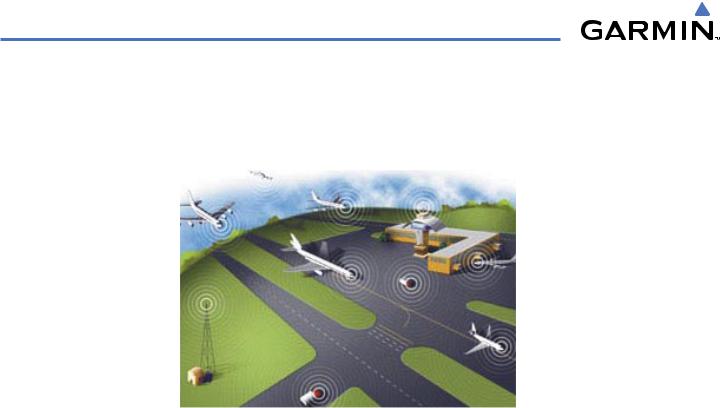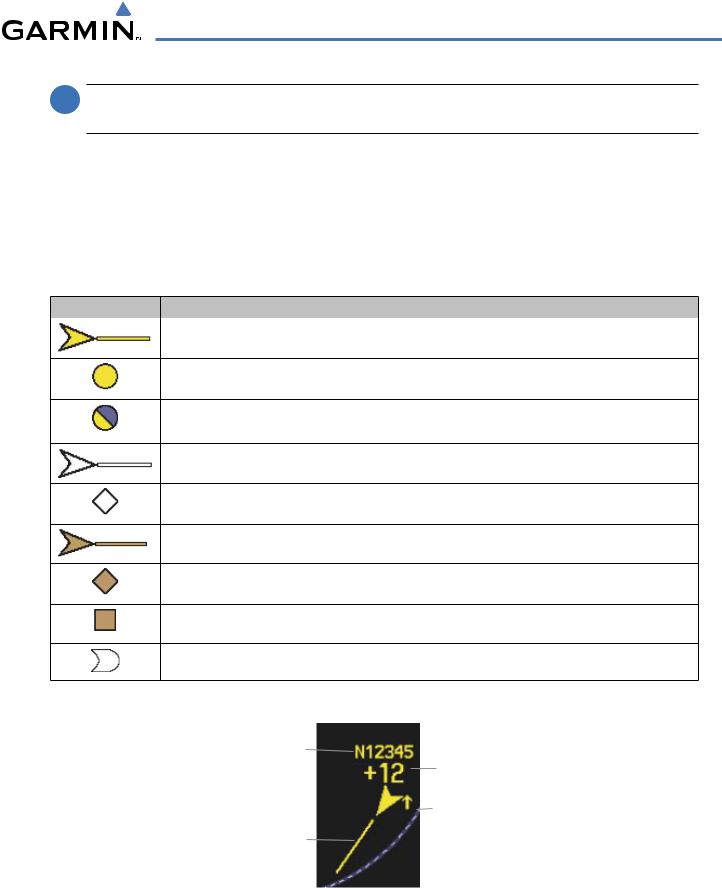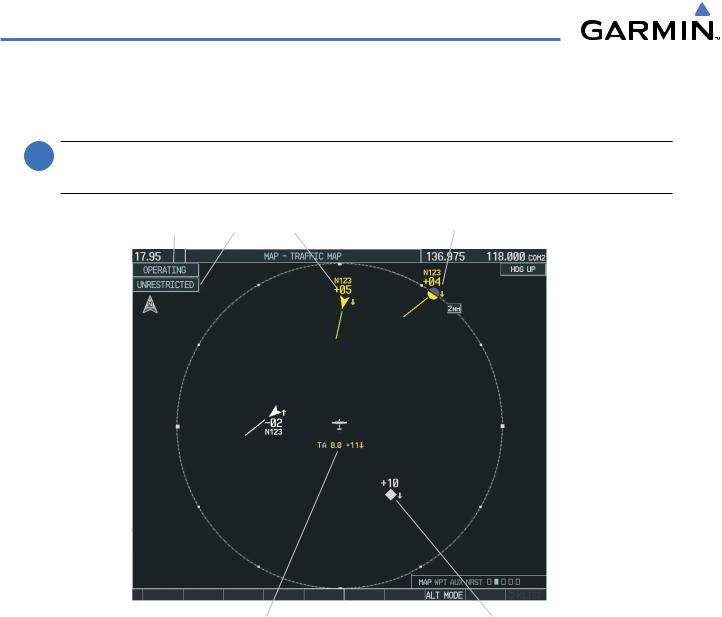
- •Section 1 System Overview
- •1.1 System Description
- •1.2 Line Replaceable Units (LRU)
- •1.3 G1000 Controls
- •PFD/MFD Controls
- •Audio Panel Controls
- •1.4 Secure Digital (SD) Cards
- •1.5 System Power-up
- •1.6 System Operation
- •Normal Display Operation
- •Reversionary Display Operation
- •AHRS Operation
- •G1000 System Annunciations
- •Softkey Function
- •GPS Receiver Operation
- •1.7 Accessing G1000 Functionality
- •Menus
- •MFD Page Groups
- •MFD System Pages
- •1.8 Display Backlighting
- •Automatic Adjustment
- •Manual Adjustment
- •Section 2 Flight Instruments
- •2.1 Flight Instruments
- •Airspeed Indicator
- •Attitude Indicator
- •Altimeter
- •Vertical Speed Indicator (VSI)
- •Vertical Deviation
- •Horizontal Situation Indicator (HSI)
- •Course Deviation Indicator (CDI)
- •2.2 Supplemental Flight Data
- •Outside Air Temperature
- •Wind Data
- •Vertical Navigation (VNV) Indications
- •2.3 PFD Annunciations and Alerting Functions
- •G1000 System Alerting
- •Marker Beacon Annunciations
- •Traffic Annunciation
- •TAWS Annunciations
- •Altitude Alerting
- •Low Altitude Annunciation
- •Minimum Descent Altitude/Decision Height Alerting
- •2.4 Abnormal Operations
- •Abnormal GPS Conditions
- •Unusual Attitudes
- •Section 3 Engine Indication System (EIS)
- •3.1 Engine Display
- •3.2 Lean Display
- •Normally-aspirated Aircraft
- •Turbocharged Aircraft
- •3.3 System Display
- •Section 4 audio panel and CNS
- •4.1 Overview
- •MFD/PFD Controls and Frequency Display
- •Audio Panel Controls
- •4.2 COM Operation
- •COM Transceiver Selection and Activation
- •COM Transceiver Manual Tuning
- •Quick-Tuning and Activating 121.500 MHz
- •Auto-tuning the COM Frequency
- •Frequency Spacing
- •Automatic Squelch
- •Volume
- •4.3 NAV Operation
- •NAV Radio Selection and Activation
- •NAV Receiver Manual Tuning
- •Auto-tuning a NAV Frequency from the MFD
- •Marker Beacon Receiver
- •DME Tuning (Optional)
- •4.4 GTX 33 Mode S Transponder
- •Transponder Controls
- •Transponder Mode Selection
- •Entering a Transponder Code
- •IDENT Function
- •Flight ID Reporting
- •4.5 Additional Audio Panel Functions
- •Power-Up
- •Mono/Stereo Headsets
- •Speaker
- •Intercom
- •Passenger Address (PA) System
- •Clearance Recorder and Player
- •Entertainment Inputs
- •4.6 Audio Panel Preflight Procedure
- •4.7 Abnormal Operation
- •Stuck Microphone
- •COM Tuning Failure
- •Audio Panel Fail-Safe Operation
- •Reversionary Mode
- •Section 5 Flight Management
- •5.1 Introduction
- •Navigation Status Box
- •5.2 Using Map Displays
- •Map Orientation
- •Map Range
- •Map Panning
- •Measuring Bearing and Distance
- •Topography
- •Map Symbols
- •Airways
- •Track Vector
- •Wind Vector
- •Nav Range Ring
- •Fuel Range Ring
- •5.3 Waypoints
- •Airports
- •Intersections
- •NDBs
- •VORs
- •User Waypoints
- •5.4 Airspaces
- •5.5 Direct-to-Navigation
- •5.6 Flight Planning
- •Flight Plan Creation
- •Adding Waypoints To An Existing Flight Plan
- •Adding Airways to a Flight Plan
- •Adding Procedures To A Stored Flight Plan
- •Flight Plan Storage
- •Flight Plan Editing
- •Along Track Offsets
- •Parallel Track
- •Activating a Flight Plan Leg
- •Inverting a Flight Plan
- •Flight Plan Views
- •Closest Point of FPL
- •5.7 Vertical Navigation
- •Altitude Constraints
- •5.8 Procedures
- •Departures
- •Arrivals
- •Approaches
- •5.9 Trip Planning
- •Trip Planning
- •5.10 RAIM Prediction
- •5.11 Navigating a Flight Plan
- •5.12 Abnormal Operation
- •Section 6 Hazard Avoidance
- •6.1 XM Satellite Weather
- •Activating Services
- •Using XM Satellite Weather Products
- •6.2 WX-500 Stormscope (Optional)
- •Setting Up Stormscope on the Navigation Map
- •Selecting the Stormscope Page
- •6.3 Terrain Proximity
- •Displaying Terrain Proximity Data
- •Terrain Proximity Page
- •6.4 TAWs (Optional)
- •Displaying TAWS Data
- •TAWS Page
- •TAWS Alerts
- •System Status
- •6.5 Traffic Information Service (TIS)
- •Displaying TRAFFIC Data
- •Traffic Map Page
- •TIS Alerts
- •System Status
- •6.6 Traffic Advisory System (TAS) (Optional)
- •TAS Symbology
- •Operation
- •Altitude Display
- •Traffic Map Page Display Range
- •TAS Alerts
- •System Status
- •6.7 ADS-B Traffic (Optional)
- •Section 7 Automatic Flight Control System
- •7.2 Flight Director Operation
- •Activating the Flight Director
- •AFCS Status Box
- •Command Bars
- •Flight Director Modes
- •7.3 Vertical Modes
- •Pitch Hold Mode (PIT)
- •Selected Altitude capture Mode (ALTs)
- •Altitude hold mode (alt)
- •Vertical Speed Mode (VS)
- •Flight Level Change Mode (FLC)
- •Vertical Navigation Modes (VPTH, ALTV)
- •Glidepath Mode (GP) (waas only)
- •Glideslope Mode (GS)
- •Go Around (GA) Mode
- •7.4 Lateral Modes
- •Roll Hold Mode (ROL)
- •Heading Select Mode (HDG)
- •Navigation mode (GPS, VOR, LOC)
- •Approach mode (GPS, VAPP, LOC)
- •Backcourse Mode (BC)
- •7.5 Autopilot Operation
- •Engaging the Autopilot
- •Control Wheel Steering
- •Disengaging the Autopilot
- •7.6 Example Procedures
- •Departure
- •Intercepting a VOR Radial
- •Flying a Flight Plan/GPS Course
- •Descent
- •Approach
- •Go Around/Missed Approach
- •7.7 AFCS Annunciations and Alerts
- •AFCS Status Alerts
- •Overspeed Protection
- •Section 8 Additional Features
- •8.1 SafeTaxi
- •SafeTaxi Cycle Number and Revision
- •8.2 ChartView
- •ChartView Softkeys
- •Terminal Procedures Charts
- •Chart Options
- •Day/Night View
- •ChartView Cycle Number and Expiration Date
- •8.3 FliteCharts
- •FliteCharts Softkeys
- •Terminal Procedures Charts
- •Chart Options
- •Day/Night View
- •FliteCharts Cycle Number and Expiration Date
- •8.4 XM Radio Entertainment (Optional)
- •Activating XM Satellite Radio Services
- •Using XM Radio
- •Automatic Audio Muting
- •8.5 Scheduler
- •8.5 Abnormal Operation
- •Annunciations and Alerts
- •Alert Level Definitions
- •Nav III Aircraft Alerts
- •CO Guardian Messages
- •G1000 System Annunciations
- •Other G1000 Aural Alerts
- •G1000 System Message Advisories
- •AFCS Alerts
- •TAWS ALERTS
- •TAWS System Status Annunciations
- •SD Card Use
- •Jeppesen Databases
- •Garmin Databases
- •Glossary
- •Frequently Asked Questions
- •General TIS Information
- •Introduction
- •TIS vs. TAS/TCAS
- •TIS Limitations
- •Map Symbols
- •Index

HAZARD AVOIDANCE
6.7 ADS-B TRAFFIC (OPTIONAL)
The Automatic Dependent Surveillance-Broadcast (ADS-B) Traffic function allows you to view other traffic in the area, when a GDL 90 data link radio is installed.
Figure 6-78 ADS-B System
ADS-B is a surveillance technology being deployed in selected areas. ADS-B broadcasts a radio transmission approximately once per second containing the aircraft’s position, velocity, identification, and other information. ADS-B can also receive reports from other suitably equipped aircraft within reception range. Additionally, these broadcasts can be received by Ground Based Transceivers (GBTs) and used to provide air traffic surveillance services. No ground infrastructure is necessary for ADS-B equipped aircraft to detect each other.
In the United States, two different data links have been adopted for use with ADS-B: 1090 MHz Extended Squitter (1090 ES) and the Universal Access Transceiver (UAT). The GDL 90 is a Universal Access Transceiver (UAT). The UAT link is intended for use by aircraft that primarily operate at 18,000 feet and below. The UAT link supports Flight Information Services-Broadcast (FIS-B).
ADS-B enables improved surveillance services, both air-to-air and air-to-ground, especially in areas where radar is ineffective due to terrain or where it is impractical or cost prohibitive. Initial applications of air-to-air ADS-B are for “advisory” use only, enhancing a pilot’s visual acquisition of other nearby equipped aircraft either when airborne or on the airport surface.
ADS-B is intended to be used both in-flight and on the airport surface. ADS-B systems should be turned “on” -- and remain “on” -- whenever operating in the air and on the airport surface, unless a change to “standby” was requested by ATC.
The ADS-B cockpit display of traffic is NOT intended to be used as a collision avoidance system and does not relieve the pilot’s responsibility to “see and avoid” other aircraft. ADS-B shall not be used for avoidance maneuvers during IMC or other times when there is no visual contact with the other target aircraft. ADS-B is intended only to assist in visual acquisition of other aircraft. No avoidance maneuvers are provided for, nor authorized, as a direct result of an ADS-B target being displayed in the cockpit.
6-64 |
Garmin G1000 Pilot’s Guide for Cessna Nav III |
190-00498-03 Rev.A |

HAZARD AVOIDANCE
 NOTE: UseofADS-BsurveillanceservicesislimitedtotheservicevolumeoftheGround-BasedTransmitter(GBT).The
NOTE: UseofADS-BsurveillanceservicesislimitedtotheservicevolumeoftheGround-BasedTransmitter(GBT).The
coverage volume of GBTs is limited to line-of-sight.
TRAFFIC DESCRIPTION
ADS-B is limited to displaying traffic in the G1000. Operation is similar to the TAS system discussed previously, with the exception of symbology. The symbols used to display ADS-B traffic are shown in Table 6-18. Above or below the traffic symbol is the traffic identifier, and altitude. A small up or down arrow next to the traffic symbol indicates that the traffic is climbing or descending at a rate of at least 500 feet per minute. The vector line that extends beyond the point of the traffic arrow is just further indication of the intruder aircraft track.
Symbol |
Description |
|
|
Traffic Advisory with directional information. |
Points in the direction of the intruder aircraft track. |
Traffic Advisory without directional information.
Traffic Advisory out of the selected display range. Displayed at outer range ring at proper bearing.
Non-threat traffic with directional information. Points in the direction of the aircraft track.
Non-threat traffic with no directional information.
Traffic located on the ground with directional information. Points in the direction of the aircraft track. Ground traffic is only displayed when own aircraft is below 1,000 feet AGL or on the ground.
Ground traffic without directional information. Ground traffic is only displayed when own aircraft is below 1,000 feet AGL or on the ground.
Non-aircraft ground traffic. Ground traffic is only displayed when own aircraft is below 1,000 feet AGL or on the ground.
Traffic with directional information, but positional accuracy is degraded. Points in the direction of the aircraft track.
Table 6-18 ADS-B Traffic Symbology
Aircraft |
|
Identification |
Relative Altitude |
(tail number |
(in this case 1200 |
or Flight ID |
feet above own |
number) |
aircraft) |
Intruder |
Altitude Trend |
Aircraft |
(up arrow |
Heading |
indicates |
(extends in |
climbing, down |
the direction |
arrow indicates |
of the aircraft |
descending) |
heading) |
|
Figure 6-79 |
Example ADS-B Traffic Advisory |
190-00498-03 Rev.A |
Garmin G1000 Pilot’s Guide for Cessna Nav III |
6-65 |

HAZARD AVOIDANCE
OPERATING MODES
The unit must be in operating mode for traffic to be displayed.
 NOTE: The GDL 90 listens to the transponder and follows the transponder mode.The only additionalADS-B mode control is altitude mode.
NOTE: The GDL 90 listens to the transponder and follows the transponder mode.The only additionalADS-B mode control is altitude mode.
Operating |
Altitude |
Traffic Advisory, Aircraft is |
Traffic, Out of |
Mode |
Mode |
500’ Above and Descending |
Range |
“Non-Bearing” Traffic, |
Proximity Traffic, 1000’ |
Distance is 8.0 nm, 1100’ |
Above and Descending, |
Above and Descending |
No Valid Velocity |
Figure 6-80 ADS-B Traffic Map Page |
|
Displaying traffic on the Traffic Map Page:
1)Turn the large FMS knob to select the Map Page Group.
2)Turn the small FMS knob to select the Traffic Map Page.
6-66 |
Garmin G1000 Pilot’s Guide for Cessna Nav III |
190-00498-03 Rev.A |

HAZARD AVOIDANCE
Changing the altitude display mode:
1)On the Traffic Page, press the ALT MODE Softkey.
2)Press one of the following softkeys:
• BELOW, NORMAL, ABOVE, or UNREST (unrestricted)
3)To return to the Traffic Page, press the BACK Softkey.
OR:
1)Press the MENU Key and turn the small FMS Knob to select one of the following:
• BELOW, NORMAL, ABOVE, or UNREST (unrestricted)
2)Press the ENT Softkey.
Changing the display range on the Traffic Page:
1)Turn the RANGE Knob.
2)The following range options are available:
•2 nm
•2 and 6 nm
•6 and 12 nm
•12 and 24 nm
•24 and 40 nm
The Traffic Map Page is in the MAP Group and displays the following information:
•Current aircraft location
•Surrounding traffic
•Range marking rings
•Current traffic mode
•OPERATING
•FAIL
•Traffic alert messages
•FAILED
•DATA FAILED
•NO DATA
•UNAVAILABLE
190-00498-03 Rev.A |
Garmin G1000 Pilot’s Guide for Cessna Nav III |
6-67 |

HAZARD AVOIDANCE
BLANK PAGE
6-68 |
Garmin G1000 Pilot’s Guide for Cessna Nav III |
190-00498-03 Rev.A |
